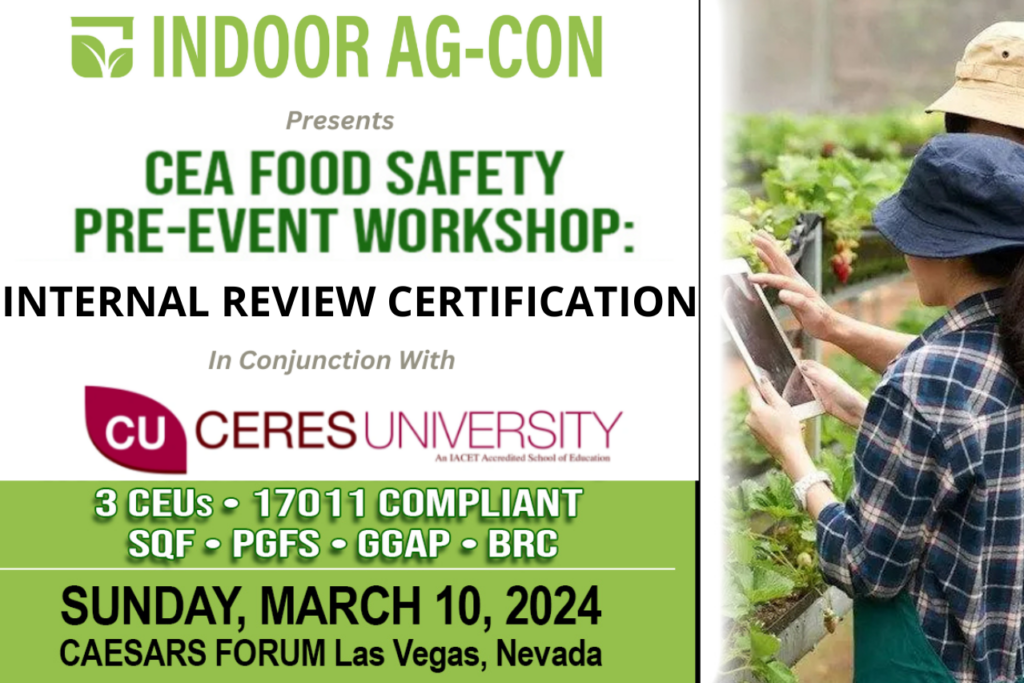CEA Food Safety Spotlight: The Benefits Of An Internal Review Audit
Indoor Ag-Con will host a CEA Food Safety Pre-Event Workshop in conjunction with Ceres University on March 10, 2024. Looking ahead to this session, we’ve launched a monthly column to explore key issues and actionable improvements you can implement for your food safety and food quality processes. This month, Dr. Karl Kolb, President, Ceres University and Ceres Certifications, International, shares how the value of an Internal Review audit is priceless to a food organization that works hard to ensure food safety, quality, authenticity, nutrition, food fraud and security programs enforce a rigorous GFSI program.
________________________________________________________________________________________________________________________________
Virtually every GFSI food safety scheme from PGFS to SQF require the staff to be qualified in Internal Review skills. Internal Review has become a required certification for those in quality assurance or compliance areas. All GFSI schemes require at least one certified individual in the company. And the internal review team is also trained in these same skills. The skill set of the qualified person is no more than what is required by a HACCP and PCQI qualification.
An internal review audit is a comprehensive evaluation conducted by qualified individuals to assess an organization’s adherence to food safety standards, regulatory requirements, and industry best practices. It involves a systematic review of processes, procedures and documentation.
Internal review goes by many names. Internal Audit, Internal Review, Self-Inspection or Audit or a title that indicates a review of internal programs to determine their effectiveness.
An Internal Review is comprised of the following major tenants:
- In this step an internal auditor or audit team must identify a clear objective of the food safety audit process. For a GFSI scheme this can involve critical prerequisite programs, HACCP, GMP’s or other important processes in the company organization. These internal audits are spread over the 12 months or 4 quarters of the audit year. Many times, the food safety scheme indicates preferred subjects like HACCP, GMPs or food fraud programs.
- What is the plan for completing the audits?
- How are corrective actions and preventative actions taking place?
- Verification of results.
- Audit evaluation.
There are many simple techniques to help make the process less arduous. Interviews, KPI analysis, review of written programs or records and observations. While the audit does cover every part of the food safety program, the manner in which it is approached, conducted and evaluated does not need to be hard to perform. There are many ways to conduct a meaningful audit. Start slow and focus on only the critical items building each year to achieve a complete and meaningful program.
How ever the internal audit is approached it is vital to the company’s commitment to food safety.
 Karl Kolb, Ph.D., is the founder and President of the High Sierra Group companies, which services more than 10,000 customers with Ceres Certifications, International (ISO 17065 food safety certifying body), HSG/AME Certified Laboratories (17025 food testing laboratories), Ceres University (Accredited, degree granting), High Sierra Chemicals and Epicure Farms.
Karl Kolb, Ph.D., is the founder and President of the High Sierra Group companies, which services more than 10,000 customers with Ceres Certifications, International (ISO 17065 food safety certifying body), HSG/AME Certified Laboratories (17025 food testing laboratories), Ceres University (Accredited, degree granting), High Sierra Chemicals and Epicure Farms.

